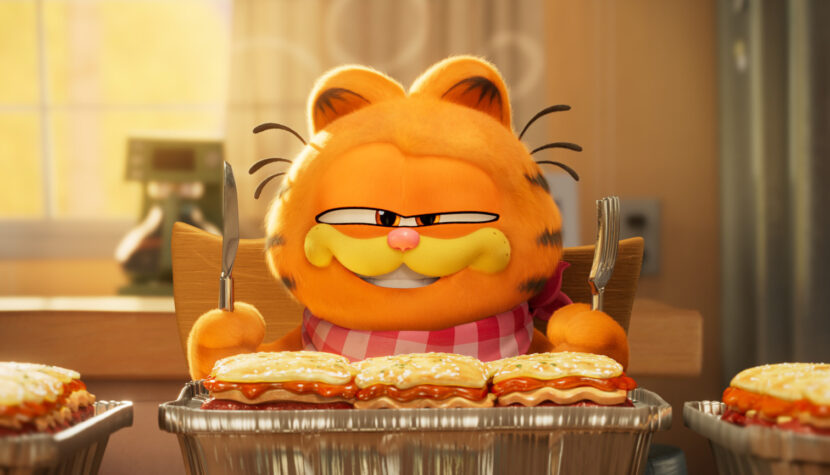GARFIELD. Deadpool among Animations [REVIEW]

The history of Garfield began rather unspectacularly, with a comic strip published in early 1976 in the “Pendleton Times” newspaper. Initially, the cat wasn’t even the main character – the series was titled “Jon” and, as one might guess, it primarily revolved around the human’s adventures. However, in 1977, comic creator Jim Davis changed the title and shifted the focus to the animal hero. With growing popularity, Garfield migrated from the local “Pendleton Times” and started appearing regularly in dozens, then hundreds of newspapers worldwide. Thus, a brand was born that remains popular to this day – its latest cinematic installment has just hit the big screen.
The new Garfield is a complete narrative reset – yet another in the brand’s history, characterized by episodicity since its inception. We can, therefore, forget with a clear conscience the awkward attempts to combine an animated cat with live-action films from the early 2000s, and we can breathe a sigh of relief and send “Garfield’s Fun Fest” and “Garfield’s Pet Force” into memory oblivion. The creators serve us a fresh origin story of the hero, who, wandering on a rainy night, finds himself under the window of an Italian restaurant. Jon opens the window for him, and thus a lifelong friendship is born – cemented by fulfilling the cat’s culinary whims. Garfield, true to his comic original, is narcissistic, lazy, and sarcastic. He doesn’t fight Odie, as in the infamous live-action movie, but treats him as a partner in crime; someone with whom he can conduct nocturnal fridge raids. Deep down, he is kind-hearted and helpful, generally: likable. His life is idyllic – meals are interspersed with sleep, play, and binge-watching Catflix, much like real cats. Of course, everything must turn 180 degrees for Garfield to undergo the obligatory “hero’s journey” – and so it happens when his long-lost father appears on the horizon.

A few weeks before the premiere, an alternative version of the Garfield poster circulated online, parodying the promotional materials of the latest Deadpool installment – instead of Wolverine’s claws, a knife and fork were in the foreground. This isn’t just an example of good real-time marketing: Garfield genuinely aspires to be the animated Deadpool. The hero regularly monologues off-screen: addressing viewers directly, breaking the fourth wall. He throws ironic comments left and right, distancing himself from the on-screen reality. The creators ensure an appropriate number of intertextual references: commenting on the acting of a “dead” opossum, Garfield jokes about Daniel Day-Lewis, and while jumping on a train, he says he performs his stunts like Tom Cruise. When he and his companions break into the Lactose Factory and the narrative sharply turns into a heist movie, the “Mission: Impossible” theme plays. During the finale, when delivery drones arrive for the rescue, we hear the distinctive “Top Gun” soundtrack. These may not be the wittiest references, but they delight the adult viewer’s eyes and ears, giving the film a postmodern charm that Shrek brought to high-budget animations over 20 years ago.
I have a small ritual: before writing a review, I like to read other reviews, mainly in English, to compare my opinion with those of other, often more experienced journalists and critics. In one review, the author laments the film’s violence and the range of jokes that children can’t understand, apparently forgetting that animated films aren’t exclusively for the youngest audience. The best animations have always been layered: perceived differently in childhood and again when revisited years later. Staying with the previous example: Shrek is first a funny story about a grumpy ogre and an extroverted donkey, and later an unrestrained satire on Disney fairy tales, overturning established tropes. It contains plenty of ambiguous humor and jokes we could only appreciate as adults, thanks to Bartosz Wierzbięta’s brilliant translation. And some violence, which would likely bother today’s overly sensitive reviewers more than children, spreading unnecessary moral panic in their texts. With Garfield, while maintaining all quality proportions, it’s similar. And there’s no need to be outraged: amid utterly bland family productions (yes, I’m looking at you, “IF“), Mark Dindal’s film, the creator of “Chicken Little” and “The Emperor’s New Groove,” is worth noting.

Finally, Garfield is a film experienced not only with the eyes and ears but also with the stomach. The screen is filled with animated food: Garfield devours countless slices of pizza and, of course, lasagna, gulps down spaghetti Bolognese, munches on potato wedges, swims in cheese, shoots hot sauce, and bombards opponents with vinaigrette salad. The creators go all out, crafting an animated response to “Bouillon and Other Passions” and “Babette’s Feast,” targeted at those who don’t necessarily fancy quail, soufflés, or turtle soup. And it must be admitted that their efforts yield the desired effect – Garfield’s appetizing magic works. The first thing I did after leaving the cinema was order a pizza: a small margherita from the cheapest pizzeria in Poznań. Nothing had tasted so good in a long time.

